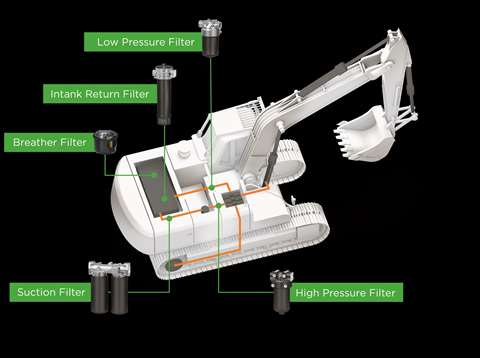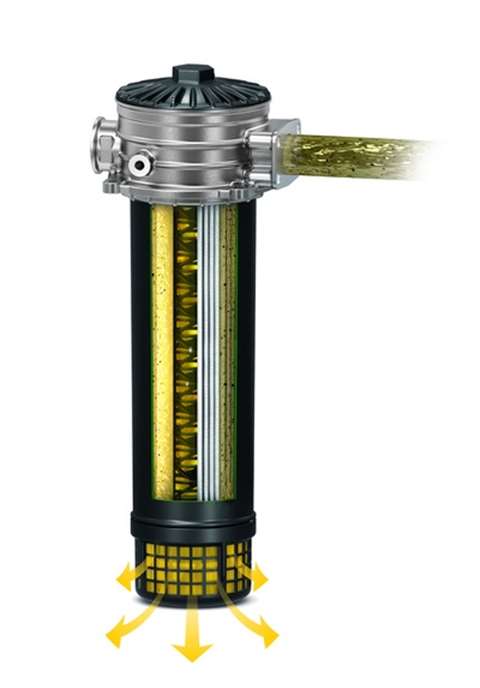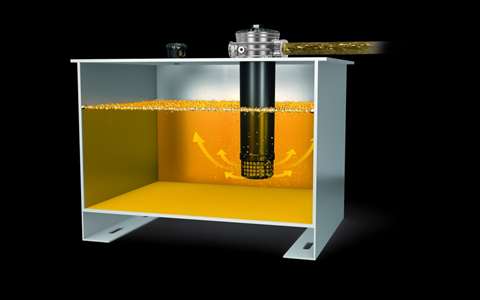Mann+Hummel targets improved performance in mobile hydraulic filters
06 June 2022
 Mann+Hummel has developed new hydraulic filter solutions for use on machines such as hydraulic excavators. (Photo: Mann+Hummel)
Mann+Hummel has developed new hydraulic filter solutions for use on machines such as hydraulic excavators. (Photo: Mann+Hummel)
Filters could be described as the unsung hero of mobile hydraulic systems. Unfiltered hydraulic fluid, loaded with particulates from pumps motors or other hardware, inevitably results in a loss of efficiency and can potentially lead to failure of the entire hydraulic system.
Mann+Hummel, the global supplier of air and liquid filtration technology, is about to launch a series of new hydraulic filter solutions for mobile machines aimed to improve efficiency and capacity, along with a new method of removing entrained air.
Mike Maertz is lead engineer, Hydraulic Filtration, at Mann+Hummel. While the company headquarters is in Ludwigsburg, Germany, Maertz heads up the activities of the worldwide Mann+Hummel hydraulic engineering network from a dedicated facility in Speyer, Germany. The team specializes in development of filters which are generally used in construction and agricultural machines.
“We cover liquid filter solutions for oil, fuel, urea and other special filter applications,” said Maertz. “Within that team are the hydraulic filters. We have development engineers around the world working on a new hydraulic product portfolio.”
Martin Postel, manager for Engineering Liquid Filters, explained more about the new portfolio. “Our target is to use specialized filter media and technologies from existing product groups to develop a new product range,” he said. “This means using our base knowledge, competences, engineering and production know-how for new product development.”
Particulate matter
 The fluid flow through an in-tank filter from Mann+Hummel. (Photo: Mann+Hummel)
The fluid flow through an in-tank filter from Mann+Hummel. (Photo: Mann+Hummel)
The particulates in hydraulic fluid are mainly a result of abrasion from the pump, where there is friction between the moving parts that create pressure within the hydraulic system. Dirt and dust can also enter the reservoir during servicing.
“Depending on the system and customer needs, the filter can be located before or after the oil pump,” Maertz said. “Another common application is to have it after the activator that’s in the return line where the oil comes back to the reservoir.”
Maertz said filter performance has improved a lot in recent years. This translates to increases in filtration efficiency and capacity, but also higher performance with regards to differential pressure. “The goal is to maintain – or even reduce – the differential pressure while increasing the particulate holding capacity,” he said. This, he added, will help to increase service intervals and cut related costs.
Too much particulate matter in the filter will cause the differential pressure to increase. Should that go beyond preset parameters, generally around 43 psi (3 bar), a warning light will illuminate on the machine control panel. This is controlled by a sensor, but Postel said the latest filters can also include sensors dedicated to testing hydraulic fluid quality. This supports predictive rather than scheduled maintenance, another route to cost reduction. But that comes with its own set of challenges.
“A challenge for us is working with the oil supplier,” Postel said. “Each company uses special additives with different chemical properties. This means we have to continuously adapt materials, including elastomers, filter media and plastic parts.”
New features
Mann+Hummel supplies both original equipment manufacturers (OEMs) and the aftermarket, meaning the company can offer like-for-like filter replacement, supported by a worldwide network of dealers.
Postel said a key target for the new product portfolio was development of a modular “toolbox” which would allow replacement of specific parts rather that the complete filter. In cases where an OEM was looking to use a hydraulic fluid with particularly aggressive characteristics, the company could supply just the specific seals needed for that application.
“We have parts which can be combined with different housings, different filter elements, different seals,” Postel said. “It’s a modular system that can provide the flexibility to support a customized solution, without having customized tools or individual products for a single customer.”
The filter medium still uses largely the same glass fiber and synthetic materials. But Mann+Hummel employed new simulation tools to achieve the best combinations of materials to more precisely balance particulate holding capacity and filtration efficiency.
“The filter medium uses a combination of layers to improve performance,” Maertz said. “This will include a prefilter for larger particles, together with a finer filter for smaller elements.
 A hydraulic return filter positioned within the reservoir. (Photo: Mann+Hummel)
A hydraulic return filter positioned within the reservoir. (Photo: Mann+Hummel)
“There’s also a metallic mesh to support the pleating. This is the core, but the simulation system has allowed us to improve our internal know-how, understand the best combinations and orientations of the filter medium.”
Another new feature is a “genuine part protector.” This consists of a small opening on the filter housing which has a reciprocal insert on the filter. Maertz said this can help to guarantee original filters are used when servicing.
Aeration reduction
A selection of filters in the new portfolio includes an aeration reducer, designed to break up air bubbles within the hydraulic fluid as it is returned to the reservoir.
“When the gas content in the oil is very high, it will influence the hydraulic cylinder behavior and control of the system,” Postel said. “When there’s 400 bar (5800 psi) of pressure, you can’t compress the oil. But you can compress the air and this will compromise the system.”
Postel said in operation air in the system can make it almost impossible to achieve an accurate action/reaction between the control joystick and machine arm. This drove development of the aeration reducer, a relatively new concept within the industry.
As with any new product, the aeration reducer came with its own set of problems – in this case, there being no existing test bench for the new component.
“There were no standards (related to performance),” Postel said. “So, we’ve looked to get international standards put in place. I’m sure competitors will go in a similar direction, so it made sense to have an international test standard. It will help to support accurate comparison.”
While new filtration technology can improve the performance of hydraulic systems in mobile machinery, Postel says there’s still no replacement for basic good advice. “If you’re bringing in new oil, it’s critical to have a new filter,” he said. “Also, you need a good tank system; it has to resist dust ingress. If you have a bad tank breather, you’ll get particles in the system and the filter will have to work unnecessarily hard.”
STAY CONNECTED




Receive the information you need when you need it through our world-leading magazines, newsletters and daily briefings.
POWER SOURCING GUIDE
The trusted reference and buyer’s guide for 83 years
The original “desktop search engine,” guiding nearly 10,000 users in more than 90 countries it is the primary reference for specifications and details on all the components that go into engine systems.
Visit Now
CONNECT WITH THE TEAM










